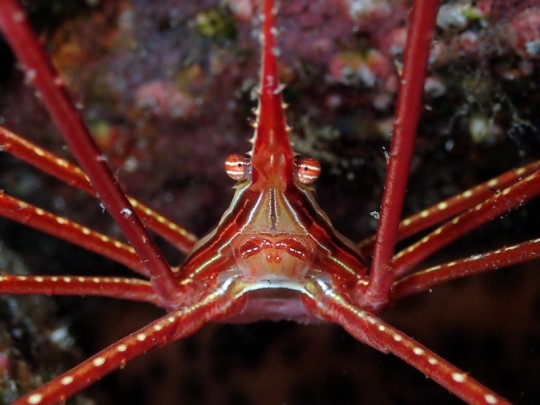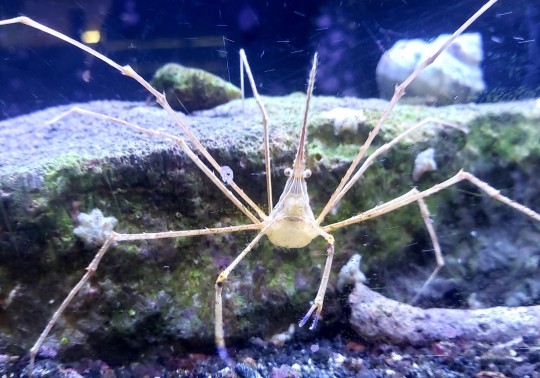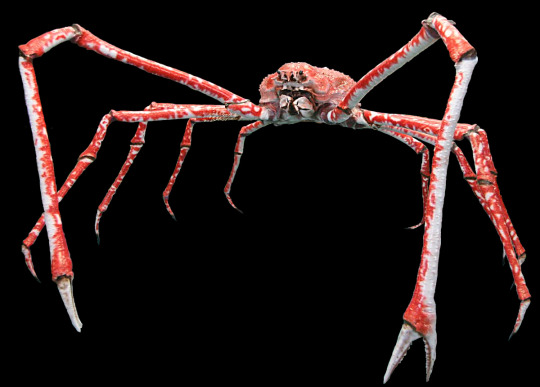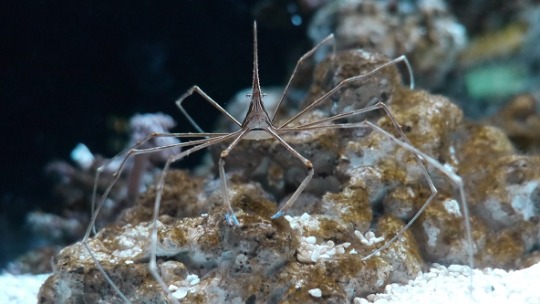#inachidae
Text

An arrow crab (Stenorhynchus lanceolatus) in Lanzerote, Canary Islands
by Verheyen Stefan
#arrow crab#crabs#crustaceans#stenorhynchus lanceolatus#stenorhynchus#inachidae#brachyura#decapoda#malacostraca#crustacea#arthropoda#wildlife: canary islands#wildlife: spain
163 notes
·
View notes
Text
Going back to my phylogenetic tree now that I can actually add to it, I have a thought. Gigantamax Centiskorch. It kind of looks like a soil centipede since it’s so long with so many legs, but I actually think that might be mere coincidence? It’s an Omukade, which is a giant youkai version of the mukade, which is a subspecies of Scolopendra subspinipes. So the question becomes whether or not I should disregard the resemblance to a Geophilomorph, or include it anyway just to be fun. After all, I classified Scizor as some obscure mantid just because it has a metallic sheen and its claws look like pincers.
I feel like Blipbug and Dottler might be another tough call. Ostensibly, they’re Coccinellids because of Orbeetle. But are they really supposed to be the grub and pupa of ladybird beetles? Dottler almost reminds me of a tortoiseshell beetle. Or Dr. Phage.
Maybe the rule should be that if the unevolved form is undecipherable, I default to lumping it with the final stage. After all, that’s why there’s a caterpillar in my phasmid branch.
Add G-Max Kingler to Decapoda as Inachidae, Snom to Lepidoptera as Dalceridae, Pincurchin to Echinodermata as Echinoidea, make some room around Chilopoda for the Sizzlipede line, around Octopoda for the Clobbopus line, and around Anthozoa for the Galarian Corsola line. I should also go back and add Mega Heracross since it’s based on a different beetle than classic Heracross albeit the same family.
As I said under the read more, the Applin line might be Worms In Apples, but they’re not worms so much as wyrms. So no dice. I’m still very interested in them, but they are all reptile: neither worms nor the caterpillars that gave rise to the trope.
Falinks kind of looks like a caterpillar or a millipede, but I need more information about it before I jump the gun.
13 notes
·
View notes
Text

Arrow Crab🦂
▪︎not my personal crab/Inachidae▪︎
•work tank photo•
0 notes
Text
The Japanese Spider Crab

Scientific name: Macrocheira kaempferi
Taxonomic Classification: Kingdom: Animalia Phylum: Arthropoda Subphylum: Crustacea Class: Malacostraca Order: Decapoda Infraorder: Brachyura Superfamily: Majoidea Family: Inachidae Genus: Macrocheira Species: Kaempferi
Common Name: Japanese Spider Crab
Nutritional Requirement:
The Japanese Spider Crab eat a variety of foods. When it is young, it eats protozoa, diatoms and smaller crabs that live on the ocean floor. When it matures enough it moves on to worms, clams, mussels, snails and sea urchins.
Growth and Development:
Female spider crabs carry a fertilized egg and when it hatches they release it. After it hatches, the crabs are planktonic larvae. The larva looks nothing like a crab but instead a translucent blob that floats on the surface. It continues on to grow legs and to become a crab.
Behavior:
The spider crab behaves like all crabs: it is a mostly active animal that drums or waves its legs to communicate. They are competitive and males usually fight ot reproduce with a female.
Reproduction:
The spider crab mates belly to belly and deposits sperm within the female. The female can store the sperm a long time before she chooses to fertilize her eggs. The female then carries the eggs in their embryonic state until they hatch into larvae and she lets them go.
Evolutionary Origins:
The earliest crabs evolved sometime in the Jurassic period and have continued to evolve into over 850 different species of crab that live around the world. Carbs have a hard exoskeleton that protects them when in danger.
Habitat:
Japanese spider crabs live off the coast of Japan and usually delve to 60 to 600 meters. They tend to live in caves, vents and holes.
Sources:
https://en.wikipedia.org/wiki/Japanese_spider_crab
https://en.wikipedia.org/wiki/Crab#Evolution
2 notes
·
View notes
Photo

Orang-Utan Crab (lat.: Achaeus japonicus) by tbanny Achaeus japonicus, sometimes known as the orang-utan crab, is a crab of the family Inachidae (spider crabs or decorator crabs) which can be observed in tropical waters of the central Indo-Pacific. With a carapace of only about 2 centimetres or 0.8 inches in diameter, it has relatively long arms, which are thickly covered with fine hairs, red or reddish brown in colour, and often laden with small bits of debris for further camouflage. It is frequently, but not always, found in association with the bubble coral Plerogyra sinuosa. [Wikipedia]
5 notes
·
View notes
Photo

"Put your hands in the air like you just don't care!" A decorator crab [Inachidae] (Oncinopus sp.3 RCI-TP) reaches out to collect food to eat during a night dive in Komodo National Park, Indonesia. Jul 2018. [Canon 5D m3] — view on Instagram https://scontent.cdninstagram.com/vp/1a52bffa097176ef2f7d92d3200d78b9/5C6E606D/t51.2885-15/sh0.08/e35/s640x640/43985324_268102370562424_3560839849248238769_n.jpg
0 notes
Video
Camposcia Retusa, known commonly as the Spider Decorator Crab, is a species of marine crustacea in the family Inachidae. The spider decorator crab is widespread throughout the tropical waters of the Indo-West Pacific area. I found this one on a night dive in Thailand. (at Similan Islands)
0 notes
Text
The Orangutan Crab

Kingdom: Animalia
Phylum: Arthropoda
Class: Malacostraca
Order: Decapoda
Family: Inachidae
Genus: Achaeus
Scientific name: Achaeus Japonicus
Habitat: In bubble coral in the Indian and Pacific Oceans.
Diet: Plankton
Reproduction: From what I have read about other crabs since I cannot find any other information about how they reproduce, crabs reproduce by laying eggs.
Growth and development: Since their shell doesn’t grow, they molt their shells. There isn’t much information on their development.
https://en.wikipedia.org/wiki/Achaeus_japonicus
https://www.afsc.noaa.gov/kodiak/shellfish/cultivation/crabgrow.htm
https://featuredcreature.com/im-going-ape-over-the-orangutan-crab/
0 notes
Text
Japanese Spider Crab
The Japanese Spider Crab has the longest leg span, reaching up to 5.5 meters (18 ft) from claw to claw, of any arthropod.


Taxonomy Classification:
Kingdom: Animalia
Phylum: Arthropoda
Subphylum: Crustacea
Class: Malacostraca
Order: Decapoda
Infraorder: Brachyura
Superfamily: Majoidea
Family: Inachidae
Genus: Macrocheira
Species: M. kaempferi
Its scientific name is Macrocheira kaempferi.
They are mostly seen on the Japanese island of Honshu, Iwate Prefecture,and Taiwan. The species tolerate temperatures from 6 to 16 degrees Celsius, but they prefer temperatures from 10 to 13 degrees Celsius. The Spider Crabs are omnivores, therefore, they eat plants and animals. “Female crabs carry the fertilized eggs...until they hatch into tiny planktonic larvae.” The planktonic larvae process depnds on the temperature(preferably 12 to 15 degrees Celsius) and can take about two months. In that stage, they are small and legless. “usually drifts as plankton at the surface of the water.” The crabs normally keep to themselves. They hunt alone and there communication between each other is unknown.
Evolutionary Origin:
“Among the 36 species found in the Koskobilo quarry, the researchers uncovered two of the oldest spider crabs yet discovered, Cretamaja granulata and Koskobilius postangustus. Spider crabs are marine crabs with pointed heads, thick bodies, and long, gangly legs. Today, there are nearly 1000 species of spider crabs, representing a good portion of the 15,000 existing decapod species (De Grave ea. 2009). They can vary in size anywhere from less than one centimeter in length (like the European long-beaked spider crab, Macropodia rostrata) to a 13-foot leg-span (Macrocheira kaempferi, the Japanese giant crab.) The discovery in Spain leaned more towards the smaller size: Cretamaja granulata was 15 millimeters in length for the central part of the crab (known as the carapace). The fossil shows it had a pear-shaped carapace from which extended two diverging spines. The discovery lengthened the evolutionary timeline of spider crabs by millions of years.”
https://en.wikipedia.org/wiki/Japanese_spider_crab
http://eol.org/pages/2924326/details
https://evolution-institute.org/article/ancient-reef-housed-oldest-spider-crabs/
0 notes
Text
Yellowline arrow crab / ノコギリイッカクガニ

Stenorhynchus seticornis
ノコギリイッカクガニ
大西洋のサンゴ礁に生息。
Yellowline arrow crab
It lives on coral reefs in the Atlantic Ocean.
Animalia Arthropoda Crustacea Decapoda Inachidae
動物界 節足動物門 甲殻綱 エビ目 クモガニ科
Sumida Aquarium, Tokyo, Japan.
すみだ水族館@東京都墨田区
#Yellowline arrow crab#Stenorhynchus seticornis#Inachidae#Decapoda#Crustacean#Sumida Aquarium#ノコギリイッカクガニ#クモガニ科#エビ目#甲殻類#すみだ水族館
0 notes
Photo

Name: Japanese spider crab (Macrocheira kaempferi)
Phylum: Arthropoda
Class: Malacostraca
Order: Decapoda
Family: Inachidae
Region: Waters around Japan.
Risk of Extinction: No info.
More Info: It is the biggest crab in the world, has the largest leg span of any arthropod, reaching up to 3.8 metres (12 ft) and weighing up to 41 pounds (19 kg)
(photo taken from http://terrific-top10.com/tag/biggest-crab/)
3 notes
·
View notes
Photo

Stenorhynchus seticornis (1855) by The Ernst Mayr Library on Flickr.
#jacques burkhardt#scientific drawings#crab#Decapoda#Inachidae#Stenorhynchus#Stenorhynchus seticornis#Yellow line arrow crab
76 notes
·
View notes